Key takeaways:
- Understanding distinct IT team roles enhances collaboration and workflow, emphasizing the value of diverse expertise.
- Building trust through active listening, transparency, and empathy fosters a supportive team environment.
- Establishing clear communication channels and utilizing collaborative tools effectively streamlines projects and enhances teamwork.
- Continuous improvement in collaboration hinges on sharing success stories, encouraging knowledge sharing, and nurturing open feedback culture.
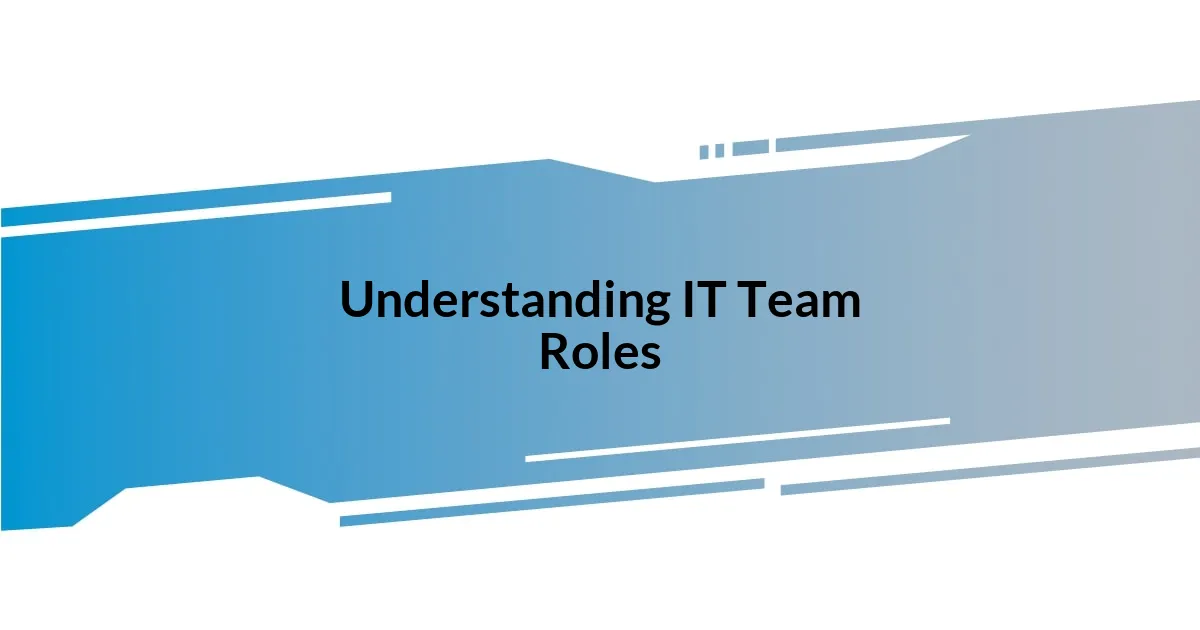
Understanding IT Team Roles
In my experience, understanding the distinct roles within an IT team transforms collaboration. For example, when a developer feels overwhelmed, I often notice how a project manager’s guidance can re-align the team’s focus, reminding me of how crucial these roles are for a smooth workflow. Have you ever considered how a systems administrator’s attention to detail can prevent major issues down the line?
Each role in IT, whether it’s the security analyst ensuring our data safety or the UX designer crafting user-friendly interfaces, brings unique strengths to the table. I remember a project where the input from a network engineer uncovered potential bottlenecks that we hadn’t anticipated, highlighting the importance of diverse expertise. What do you think would happen if one of those roles was overlooked?
Furthermore, seeing how these roles interact often reveals deeper insights into team dynamics. There’s something satisfying about watching a recent grad, brimming with fresh ideas, collaborate with a seasoned IT veteran, exchanging knowledge and fostering growth. Isn’t it fascinating how these different perspectives can lead to innovative solutions?
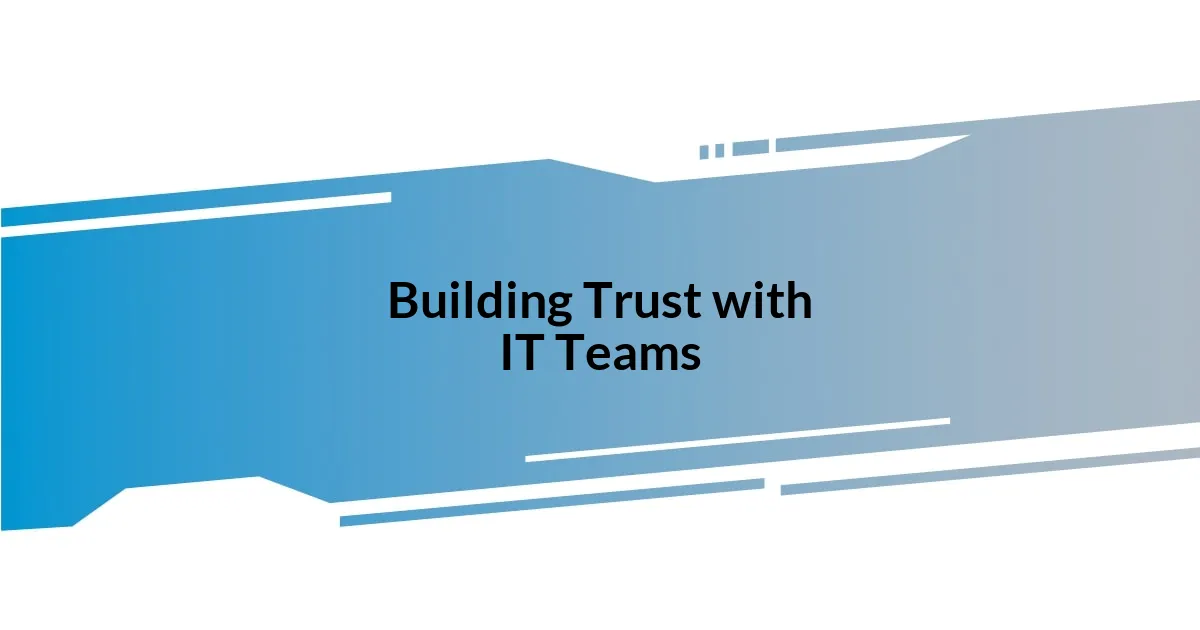
Building Trust with IT Teams
Building trust with IT teams is essential for an effective collaboration. From my experience, I’ve learned that acknowledging their expertise and valuing their opinions goes a long way. There was a time during a project when I hesitated to share my ideas because I feared they might not resonate with the tech-savvy team. However, once I opened up, I witnessed how they genuinely appreciated my input, and our mutual respect flourished. This openness not only built bridges but also encouraged the team to voice their thoughts freely.
To build that trust, it helps to focus on a few key practices:
- Active Listening: Make it a point to listen to their suggestions and concerns without interruption.
- Transparency: Share project goals, expectations, and any setbacks openly to foster honesty.
- Acknowledge Successes: Celebrate the achievements of the IT team to make them feel valued.
- Empathy: Try to understand challenges they face; showing that you care nurtures trust.
- Consistent Communication: Regularly check in to maintain a steady flow of dialogue.
Trust isn’t built overnight, but through these practices, I’ve witnessed teams come together, creating not just colleagues but a supportive network.

Establishing Clear Communication Channels
Establishing clear communication channels is vital when collaborating with IT teams. I’ve found that having designated tools for project updates makes a world of difference. For instance, when I introduced a project management tool in a previous team, we suddenly had a shared space to track tasks and prioritize our workflows. The excitement was palpable—it felt like we had finally uncovered a treasure map guiding us toward our goals.
In another situation, I remember an instance where miscommunication led to a significant delay in project deliverables. We all used different methods of communication; some preferred emails, while others were in favor of instant messaging. By implementing regular catch-up meetings, we not only streamlined our communication but also nurtured relationships. It changed the way we collaborated. Do you think fostering a routine that brings everyone together can create a more cohesive environment?
The importance of asynchronous communication can’t be overlooked either. I recall a time I was working with a globally distributed team, where time zones created obstacles for real-time discussions. Utilizing tools like shared documents helped us make progress even when some members were offline. We could build on each other’s ideas without missing a beat, showcasing the beauty of adaptability. Isn’t it fascinating how a small shift in how we communicate can create a ripple effect, transforming the whole collaborative experience?
| Communication Method | Benefits |
|---|---|
| Allows detailed explanations and is easily searchable. | |
| Instant Messaging | Facilitates quick questions and real-time interaction. |
| Video Calls | Encourages face-to-face interaction, building rapport. |
| Project Management Tools | Keeps all team members aligned and organized. |
| Shared Documents | Supports collaboration and accessibility for global teams. |
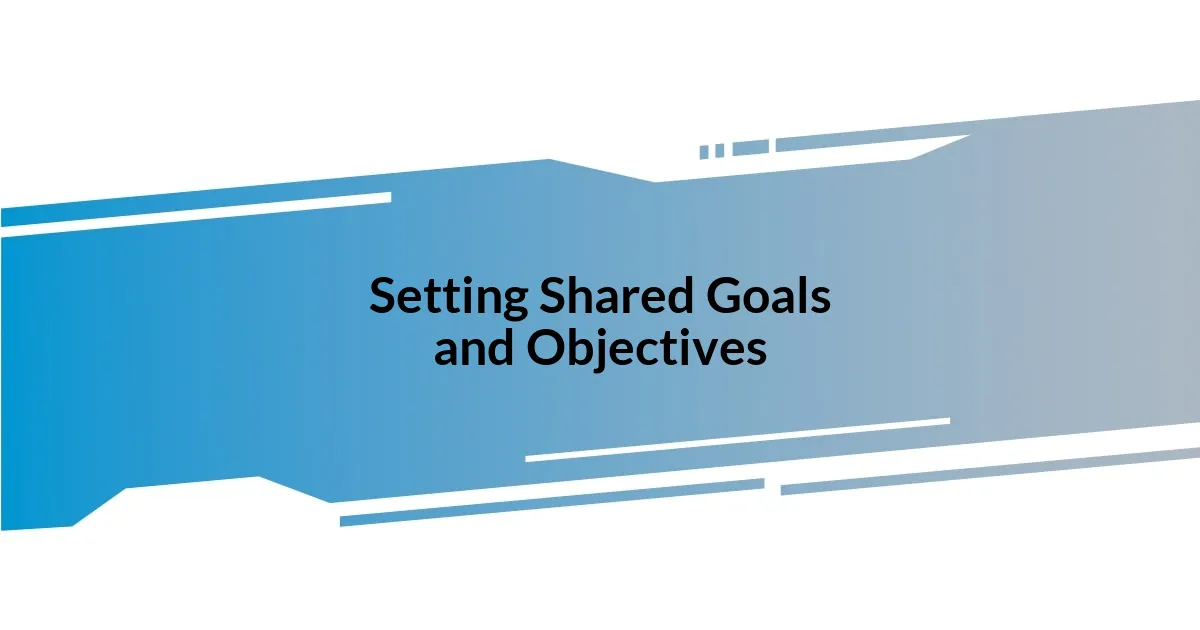
Setting Shared Goals and Objectives
Setting shared goals and objectives is foundational when collaborating with IT teams. I remember a project where we meticulously defined our objectives together, allowing each team member to contribute their perspective. This collaborative goal-setting not only clarified our direction but also instilled a sense of ownership among all involved. Have you ever noticed how when everyone has a stake in the outcomes, engagement skyrockets?
One approach I found impactful is aligning our goals with the organization’s overall vision. During a recent initiative, we explored how our IT deliverables could support broader business objectives. This connection not only made our tasks feel more meaningful but also energized the team. The thrill of knowing we were part of something larger created a unifying spirit. Reflecting on your own projects, how often do you bring the team into that bigger picture?
Additionally, establishing measurable objectives has proven essential for us. In a past experience, we used SMART criteria—specific, measurable, achievable, relevant, and time-bound—guiding us in shaping concrete goals that everyone understood. By tracking our progress against these benchmarks, we fostered a sense of accountability and celebrated milestones along the way. Who doesn’t appreciate a good celebration, especially when it reinforces teamwork?

Utilizing Collaborative Tools Effectively
Utilizing collaborative tools effectively can truly elevate a team’s performance. One example that stands out in my memory is when our team adopted a visual task board. I was initially skeptical about its usefulness, but the thrill of dragging tasks across columns kept everyone focused and energized. Each movement represented progress, and it fostered a sense of achievement. Have you experienced how visual progress can motivate a team?
In another instance, I found that integrating real-time editing features in shared documents was a game changer. Collaborating on a project pitch, we could all jump in and contribute simultaneously, making the process not only efficient but also dynamic. I remember the excitement when we seamlessly built upon each other’s ideas, almost like we were jamming on a creative project. It’s amazing how technology can transform a solitary task into a collaborative symphony, isn’t it?
Finally, the right tools help facilitate feedback loops that are vital in tech environments. Taking feedback directly within the tools we use allowed for timely and constructive conversations. I once worked on a software development project where using comment threads led to quick resolution of issues. It created an environment of continuous improvement and trust among team members. Don’t you feel that openness to feedback can catalyze innovation in a team?
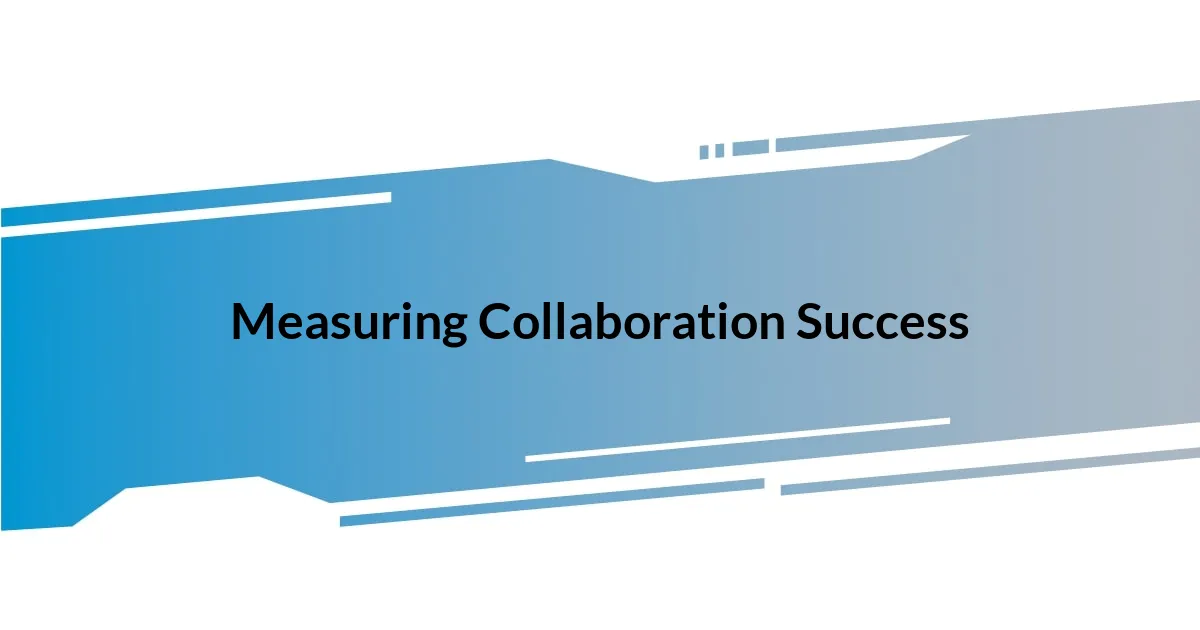
Measuring Collaboration Success
Understanding how to measure collaboration success is essential for continuous improvement. I’ve experienced firsthand how tracking both qualitative and quantitative metrics can give real insight. For instance, during one project, we measured our collaboration through regular feedback sessions and by analyzing how quickly we resolved issues. The combination of these metrics allowed us not just to celebrate successes but also to identify areas needing refinement. When was the last time you reviewed your collaboration processes?
Another valuable method I’ve found effective is assessing team engagement through surveys. After one particularly intense sprint, we sent out a questionnaire gauging our members’ feelings on team dynamics and communication efficiency. The results were eye-opening! We discovered that while some felt empowered, others struggled with clarity on their roles. This taught me the importance of creating space for everyone to voice their experiences. Have you ever realized that a simple survey could unlock deeper insights into team health?
Finally, I’ve seen the power of setting up regular retrospectives to discuss our collaboration outcomes. In a past project, we scheduled these meetings at the end of each major phase, allowing us to reflect and adjust our strategies promptly. I remember the honesty and openness in those discussions; it wasn’t just about metrics but about feelings and experiences. It reinforced the idea that measuring success goes beyond numbers; it’s deeply personal. When you reflect with your team, what deeper truths about collaboration come to light?
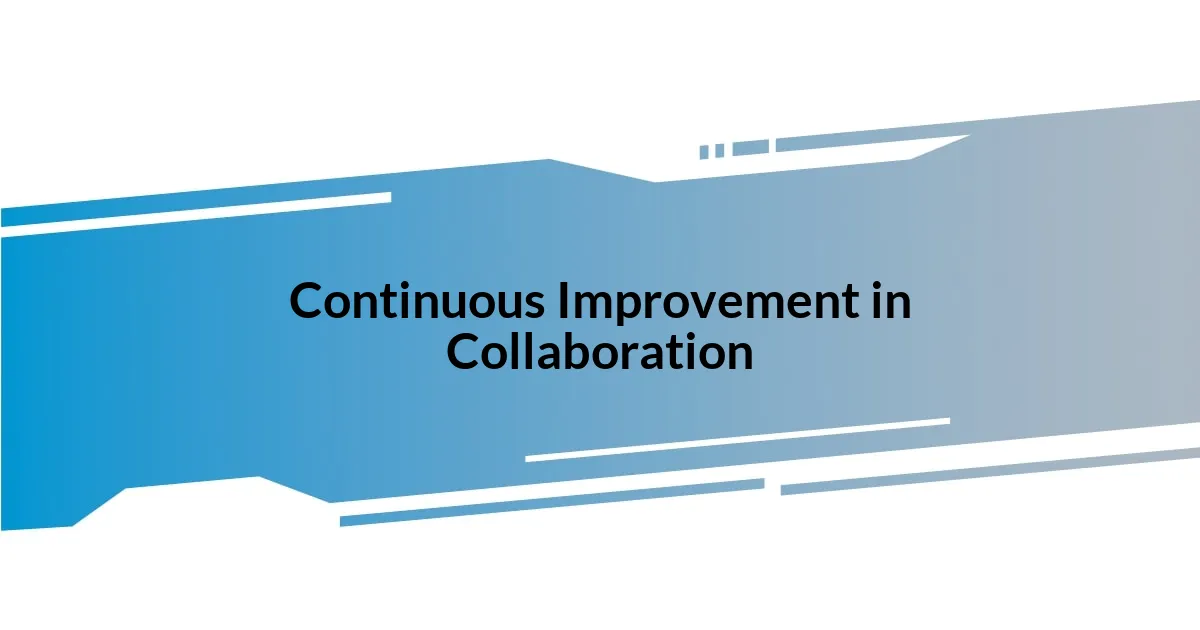
Continuous Improvement in Collaboration
Improving collaboration isn’t just about implementing new tools; it’s also about fostering a culture that values growth. I recall a project where we introduced a practice of sharing “collaboration success stories” during weekly meetings. It was fascinating to hear how small changes, like weekly check-ins or adjusting meeting agendas, led to meaningful improvements. Have you ever noticed how highlighting success can spark inspiration within a team?
In my experience, one of the most powerful ways to boost collaboration is by encouraging team members to share their learning experiences. During a particularly technical project, I initiated “knowledge share” sessions, where teammates could present something they discovered or a challenge they overcame. The enthusiasm in the room was palpable; it felt like a celebration of learning. What if your team could turn their challenges into opportunities for collective growth?
Constant feedback is crucial for refining our collaborative efforts. I’ve found that setting up informal “coffee catch-ups” can be incredibly effective. In one instance, I would grab a coffee with a teammate every other week to casually discuss what was working and what wasn’t. These relaxed conversations often led to breakthroughs, creating a safe space where we could express frustrations and brainstorm solutions together. How do you cultivate a culture of open communication within your team?